Email signatures for PhD students (content, tips and examples)
A lot of communication in academia occurs via email. Therefore, the power of a concise and effective email signature should not be underestimated. Find out how to create a professional email signature, and what to include, as a PhD student.

Why PhD students should have professional email signatures
Key elements to include in email signatures for phd students, #1 know your audience when creating an email signature, #2 keep your email signature short and simple, #3 include hyperlinks in your email signature instead of long web addresses, #4 should i include a picture in my email signature as a phd student, creating an email signature in outlook, creating an email signature in gmail, making use of email signature templates, 4 examples of email signatures for phd students.
While Zoom, Microsoft Teams and co. become increasingly popular tools of communication, emails remain a key way of communicating in academia.
Therefore, a professional email signature in academia is a must. PhD students are no exception to this rule.
Some PhD students have to ambition to pursue an academic career, while others already know that they want to leave academia. Regardless of their ambitions, PhD students benefit from establishing all-around academic profiles , to be competitive in the (academic and non-academic) job market.
An all-around academic profile includes professional networks and relations with colleagues and partners within and outside of academia. Think of joining an academic network, collaborating with policymakers, working with communities, or partnering with a private enterprise.
When getting in touch with people via email, you should make it as easy as possible for them. A proper email signature reminds them who you are, how to find out more about you, and how to contact you.
A proper email signature establishes credibility and trustworthiness.
People receive many emails every day. Don’t just expect them to remember you. Whether they answer or not may be the result of a split-second decision of how much effort it involves. And it can be annoying to first find relevant information about you.
Don’t take that chance. Instead, help the readers of your emails out by providing them with a proper email signature to establish legitimacy.
The best content of an email signature for PhD students may depend on their unique situations. The PhD student’s current (research) activities, their ambitions, and the purpose of emails all play a role.
For instance, PhD students applying for postdoc positions should include their ORCID IDs in their email signatures. PhD students looking for collaboration with community groups may want to highlight a previous collaborative project in which they were involved.
That said, there are key elements to include in every email signature as a PhD student:
- Your full name. This is a no-brainer. If people easily confuse your first name with your surname, make sure to indicate clearly which one is which.
- Your current function or position. There are many different ways to describe your current role, and they are often context-specific. It could be, for instance, “PhD student”, “PhD candidate”, “Doctoral researcher”, or “Postgraduate student”. Try to figure out what the standardised description is in your context. Furthermore, you can provide some more information by specifying, for instance, that you are a “PhD student in social psychology” or a “Doctoral researcher in archaeology”.
- Your additional function or position if it is relevant to your work. Many PhD students work part-time or have side hustles next to their PhD. If the additional function or position fits the image that you want to convey, then add it to your signature. For instance, you can include that you are a research assistant working on an ongoing project, or a teaching assistant. If you deliver pizzas or babysit next to your PhD to pay the bills, and if it does not directly contribute to your future career ambitions, don’t include it.
- The name of your university, department or lab. Include the name of your university. Some PhD students also include the Faculty in which they are based, or their department or research school.
- Your email address. Yes, you read that right: Include your email address in your email signature. Why? Because sometimes your address can get lost when your email is forwarded. Remember, make it as easy as possible for the reader to find your contact details.
- Optional but recommended: Links to online profiles and accounts. Think of LinkedIn, Twitter, ORCID ID , etcetera. However, only include them if they are used regularly, and for professional purposes! If you have one, you should also include the link to your personal academic website. (For more information, check out the post I wrote on the value of personal academic websites for PhD students !)
- Optional: Credentials. If you want to highlight, for instance, your previous degrees, you can include them after your name.
- Optional: Phone number. If you have an office phone number and are easily reachable via this number, you can include it. You can also include your number, but you do not have to! For instance, if you teach and send a lot of emails to students but don’t want your students to know your private number, it is perfectly fine not to include it in your email signature.
You may also like: The most useful academic social networking sites for PhD students
Tips for creating a convincing email signature as a PhD student
An email signature is part of your ‘personal brand’. This may seem strange to hear in the context of academia. However, think of it as the impression that you want others to have of you!
Therefore, start thinking about your ambitions before creating your email signature.
- Is the goal to present yourself as a scholar with expertise in a specific field?
- Is the goal to establish connections outside of academia for future job opportunities?
- Is the goal to communicate with students and let them know how to contact you and where your office is located?
Think about questions like these when you decide what to include in your email signature.
It can also make sense to create several email signatures for different purposes.
While a nice design is appreciated, don’t go crazy when creating your email signature.
Don’t include too many colours or too many different fonts. Make sure that it looks professional, and not like the artwork of a first-grader.
Furthermore, no one wants to read the long text in an email signature. So make sure that with one look, someone can see all relevant information.
One way to reduce the text in an email signature is with hyperlinks.
Don’t hyperlink every word. For instance, you don’t have to hyperlink the name of your university.
However, if you work as part of a specific project which has a website, you could include a hyperlink. Let’s assume your project is called CLIMATE.
Highlight the word CLIMATE with your cursor, then click on the link symbol:

A popup window will appear where you can include the full hyperlink. Your actual text will look like this:

And if people click on the underlined section, the project website will automatically appear.
Think carefully about whether or not to include a picture in your email signature.
In recent years, a lot of attention has been paid to biases within academia, for instance when it comes to hiring people.
So while it may be encouraged to include a picture in some contexts, in others it may not be appreciated (anymore) if a picture is included.
I think that the trend goes toward not including photos in email signatures. However, if you are unsure, ask some people from your university and your field what they think about it.
How to create an email signature as a PhD student
There are different ways to create email signatures. The easiest way is to make use of the in-built signature function of your email host.
In the web version of Outlook (www.outlook.com), for instance, you can click on ‘s ettings ‘ in the righthand corner.
Then you click on ‘ all settings ‘. A popup window will appear.
Under ‘ compose and reply ‘, you can create your email signature:
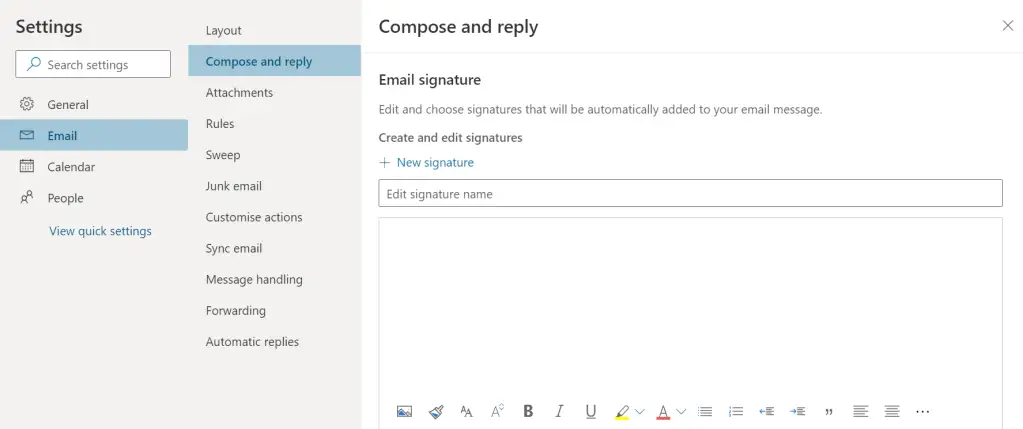
You can see that there are many text-editing options, including pictures that can be added, different fonts, colours, alignments etcetera.
If you use Gmail (www.gmail.com), you also click on ‘ settings ‘ in the righthand corner. Next, you click on ‘ see all settings ‘.
After scrolling down for a bit, you will come across ‘ signature ‘. After clicking on ‘ create new ‘, you can give your signature a name and include all relevant information:
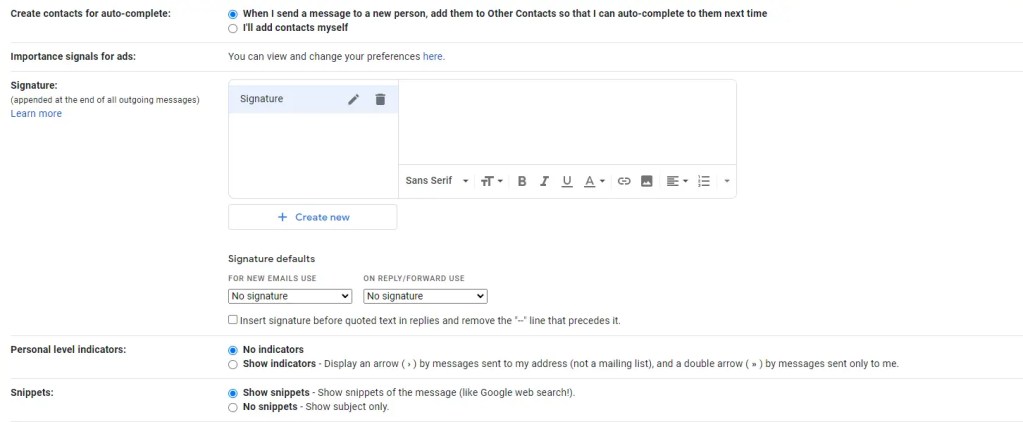
The text-editing options, similar to Outlook, include the opportunity to include pictures, different fonts, colours, bullet points, hyperlinks, etcetera.
Templates can be a great way to create nicely designed email signatures, also as a PhD student.
There are numerous websites online that help you to create an email signature. However, many of them cost money!
There are also free options to create email signatures as a PhD student:
- Microsoft Word has free templates: Just create a new document and search for “ email signature s”.
- Canva also has many email signature templates, free of charge!
- Or just browse Google for nice email signatures, and simply recreate the design on your own. It is not that difficult.
In the first example, Jane Doe decided to include her credentials and explains the subject area of her PhD. She also includes her phone number and email address and provides links to her list of publications and her online university profile. Jane’s ORCID ID and social media accounts are shown via symbols, which also include hyperlinks. Thus, readers can simply click on the symbols and reach her profiles.
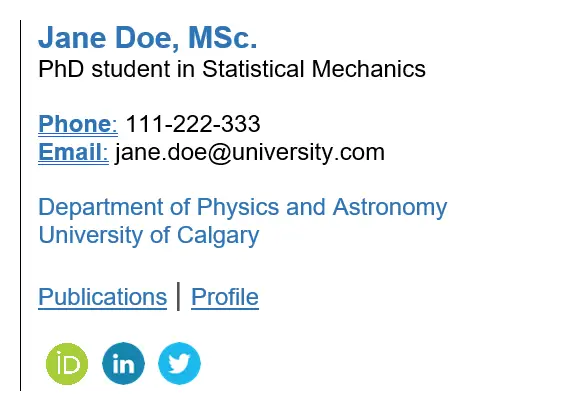
In the second example, John Doe decided to highlight his position as a doctoral researcher, as well as his additional position as a teaching assistant. He provides the university’s name, the name of the faculty and his particular school. Furthermore, he includes his room number and office hours. It can be assumed that John has a lot of contact with students as a teaching assistant, and therefore decided to include this information in his email signature.

In the third example, Joan Doe decided to include her headshot in her email signature. Overall, she went for a bold design. She is a postgraduate student at a school of fine and performance arts and wants this background to be reflected in her email signature. She also provides a link to her ort website and links to her ongoing projects, publications and her ORCID record.

In the fourth example, James Doe went for a more traditional look and decided to include the university’s logo. He defines his position as ‘PhD student in Sociology’ and indicates his participation in a research project, which is linked to the project’s website. Different to the previous examples, James also included his most recent publications. However, instead of providing the full references which would result in a very long email signature, he opted for a short title and included hyperlinks again.

The four examples are entirely made-up email signatures to showcase different styles and options.
My advice: take some time to create your email signature. Be creative and play around with different styles and information, and find out what email signature fits best to your PhD journey!
Master Academia
Get new content delivered directly to your inbox.
Subscribe and receive Master Academia's quarterly newsletter.
A guide for first year PhD students: Expectations, responsibilities, advice
How to introduce yourself in a conference presentation (in six simple steps), related articles.

The value of a personal academic website

Powerful LinkedIn headlines for students with no work experience

How to network during an online academic conference

5 proven ways to become an academic peer reviewer

How to Use a Doctorate with Your Name
—- For more on the the use of Port-Nominal Abbreviations , see that page . —- For more on use of an Honorary Doctorate , see that page . How to Use a Doctorate with Your Name
Here are the forms to use when addressing a person addressed as Dr. See the discussion below “How to Use a Doctorate with Your Name 1-2-3-4-5” for more information on who typically does use Dr. as part of their name and who does not.
—- Envelope or address block on letter or email to their office/place of work: ——– (Full Name), (Post-nominal abbreviation for doctorate held). ——– ( Name of office/place of work if appropriate) ——– (Address)
—- Social/Personal envelope: ——– Dr. (Full Name) ——– (Address)
—- Salutation – for both official & social: ——– Dear Dr. (Surname): How to Use a Doctorate with Your Name
Robert Hickey author of “Honor & Respect”
How to Use a Doctorate with Your Name: 1-2-3-4-5
—- #1) Holders of doctorates who work in academia or research institutions are addressed as ‘Dr. (Name)’ professionally and socially in a salutation or conversation. Thus, a Ph.D. professor at a college, a Ph.D. in biology doing scientific research, and a Ph.D. principal at an elementary school all use Dr. (Name) and everybody thinks it is normal.
—- NOTE: At some universities it is traditional to address faculty holding of academic doctorates as ‘Mr. (Name)’ or ‘Professor (Name)’ and not to address as ‘Dr. (Name)’. For those outside the academic community it is acceptable to follow the insider’s rule or to address holders of doctorates as ‘Dr. (Name)’ in writing or oral address.
—- #2) Protestant clergy with doctorates are addressed as ‘Dr. (Name)’ in a salutation or conversation. I specify ‘Protestant’ here because not all clergy is. For example, neither priests – addressed in a salutation or conversation as Father [Name] – nor rabbis – addressed as Rabbi [Name] – holding doctorates are ever addressed as Dr. [Name] . In a salutation or conversation they stick with Father[Name] and Rabbi [Name].
—- #3) Holders of doctorates who work outside academia or research don’t always prefer to be addressed as ‘Dr. (Name)’. in a salutation or conversation. —- —- A) In the USA ‘Dr.’ may be used depending on the work environment and/or when the degree isn’t pertinent to the conversation. E.g., a Ph.D. in finance working at a bank or a Ph.D. in American history working in software development are not likely to insist on being addressed as ‘ Dr. (Name)’ . But always ask for their preference. Use of, or omitting, the honorific can be a sensitive issue to some individuals! —- —- B) And, outside the U.S.A. everyone holding a doctorate will want to be addressed as ‘Dr. (Name)’ in every instance.
—- #4) In hospitals and healthcare environments historically there was a practice that only physicians (medical doctors, osteopaths, dentists, podiatrists, veterinarians, etc. ) are addressed as ‘Dr. (Name)’. This was explained to be out of consideration for the patients who want to know who ‘the doctors’ are and who are nurses and allied healthcare professionals.
—- That made for some unhappy professionals who earned doctorates in hospital administration, pharmacy, physical therapy and nursing, etc. – who felt they too were properly addressed as ‘Dr. (Name)’ . It’s my understanding that today all the holders of doctorates are addressed as Dr. (Name) and hospitals (etc.) have figured out other ways to define which doctor is a physician, which is a physical therapist and which is a nurse anesthetist.
—- #5) All that said, ultimately how one is addressed by others is up to the individual and usually everyone goes along. For example, if you and I meet a woman who identifies herself as ‘Monsignor Alice’ … I think it is unlikely she’s a Roman Catholic Monsignor. And, it’s unusual she has only one name, like Pink, Rhianna, Sting, Cher, or Madonna. But we should directly address her in conversation as ‘Monsignor Alice,’ it’s nice to meet you …’ because that’s what she says her name is. How to Use a Doctorate with Your Name
—- But, when she’s out of range, we will all be talking about her.
—- —- – Robert Hickey
Related Healthcare Links -V — — Chiropractor / Doctor of Chiropractic Medicine -V — — Dentist / Doctor of Dentistry -V — — Medical Doctor / Doctor of Medicine -V — — Military Physician / Armed Services -V — — Optometrist / Doctor of Optometry -V — — Osteopath / Doctor of Osteopathy -V — — Podiatrist / Doctor of Podiatry -V — — Veterinarian / Doctor of Veterinary Medicine
More Related Healthcare Links: -V — — Person holding a doctorate -V — — Pharmacist / Doctor of Pharmacy -V — — Psychologist -V — — Therapist
Related Links: —- —- —- Principal —- —- —- Headmaster —- —- —- President College University —- —- —- President of a School —- —- —- Chancellor —- —- —- Professor
When To Use Dr. (Name) and When To Use (Name), Ph.D.?
My daughter is receiving her Ph.D. and will be teaching. I would like to give her a name plate for her desk. Should it be ‘Dr. (Full Name)’ or ‘(Full Name), Ph.D. ‘? ——————- – AP
Dear AP, How to Use a Doctorate with Your Name
‘(Full Name), Ph.D.’ is the official form of her name. You will use it on the envelope, or in the address block of a letter, when you write to her with regard to her professional pursuits. This is the form the university will use when she is listed among the faculty. It is used by the degree holder, when specifying the exact degree is pertinent – like on business cards or in a list of academics.
‘Dr. (Full Name)’ is the social form of her name. You will use it when you write her name on a personal letter’s envelope, e.g., one sent to her home. This is the form everyone will use on the envelope when they send her a birthday or holiday card. It is rarely used by the degree holder since one does not correctly give oneself an honorific. The degree holder – in their signature or when introducing him or herself – just uses their name … no ‘Dr.’ It’s up to the other person to add the ‘Dr.’ E.g., I just introduce myself as ‘Robert Hickey’ – never ‘Mr. Robert Hickey.’
Sometimes you will observe a physician in a healthcare setting introducing him or herself as ‘Dr. (Name)’ – but there it is for the patient’s benefit to know they are the physician in a field of people wearing seemingly identical white coats!
‘Dr. (Surname)’ is the conversational form of her name. Use it both officially and socially in a letter’s salutation as well as in oral conversation.
So, for an office name plate use the official form of her name – (Full Name), Ph.D.
– Robert Hickey
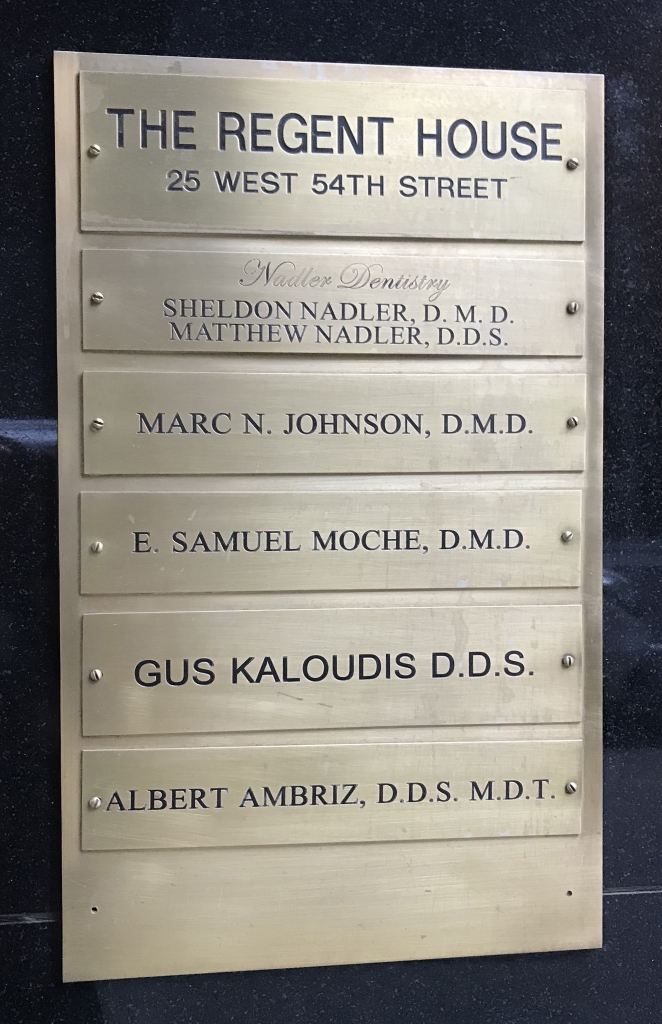
Doctors present the official form of their name to the public: (Full Name) (Pertinent post-nominals for the service offered). The social form of their name does not include their degree: Dr. (Full Name). In both official and social salutations and conversations patients use Dr. (Name).

If My Doctorate is in Music, am I ‘Dr.’?
I hold a DMA, Doctorate in Music, from a Boston university and am a Church Music Director. Please could you advise me as to whether it is acceptable for the church where I work to list me in the service bulletins as: ‘Dr. (First name) + (Last name) ‘? —————- – CJ
Dear CJ: How to Use a Doctorate with your Name It is correct to list yourself in the bulletin using the professional form of your name … (First name) + (Last name), DMA. It specifies your academic credential in your professional domain.
Among protestant denominations many address their clergy with a doctorate orally and in a salutation as Dr. (Surname). If your church is one of those, and it is your preference is to be Dr. (Surnhttps://formsofaddress.info/wp-admin/post.php?post=13983&action=edit#ame), tell everyone that it is your preference to be addressed Dr. (Surname).
Usually academics and researchers who go by Dr. (Surname) professionally – use Dr. (Surname) socially. But ultimately whether a particular Ph.D. holder is ‘Dr. (Name)’ socially … especially outside of healthcare, academia or research … is at the preference of the bearer. Some insist, some don’t care, others say they answer to anything they are called. Ultimately your name belongs to you and if you want to be Dr. (Surname), then it’s your right to request everyone address you that way.
– Robert Hickey How to Use a Doctorate with your Name
May I Call Myself Dr. (Name) if my Degree Is Not Related to the Service I Offer?
I have a Ph.D. and license in counseling. Recently I sent out an announcement for a yoga class I will be teaching. The state of Colorado says I should not teach yoga as “Dr. (Name)”. How can I convince them I can? ——– – Kevin S., Ph.D., L.P.C., C.M.T., I.K.Y.T.A. , Counseling, Yoga Therapy, Integrative Health & Healing
Dear Dr. Kevin, How to Use a Doctorate with your Name
Your Ph.D. is in a field not related to the service you are offering.
A couple of typical practices I observe in the USA come to mind:
Professionals use with their name the degrees pertinent to their profession service. The degrees and certifications are provided for the benefit of the public so the public can quickly evaluate your credentials.
Here’s what I mean by pertinent . A pastor who would be the Reverend (Full Name) & Pastor (Name) at church on Sundays, would not use the Reverend (Full Name) & Pastor (Name) when teaching English Monday through Friday, at the local high school. That he or she is the Reverend might be mentioned in a complete biography or introduction. It just isn’t part of his/her name at school.
So, I can see if you are using ‘Dr. (Name)’ when offering a class in yoga, and your doctorate is not directly to the service you are offering, say a doctorate physical therapy or kinesthetics …. it would be confusing to me … and the state officials must think it is misleading to the public.
– Robert Hickey How to Use a Doctorate with Your Name

Should I Use Dr. or Ph.D. on an Invitation?
If a person holds a Ph.D., should his or her name be ‘Dr. (name)’ a wedding invitation? Or ‘( Name), Ph.D.’ ? Is this true for the father of the bride? The groom? Is the rule for names on wedding invitations and wedding envelopes different that the guidelines for social correspondence? ————– – Beverly Russell, Winchester, Virginia
Dear Ms. Russell: Wedding invitations and their envelopes are social correspondence. Post-nominal abbreviations ( Ph.D. is a post nominal abbreviation) aren’t used on social correspondence:
—- —- DON’T use Ph.D.
—- —- DO use Dr. (Name)
Another question that typically comes up is whether to use Doctor or Dr. (spelled out or abbreviated) on the invitation or on the mailing envelope?
The rule is to spell out everything and not to use abbreviations unless space is an issue.
But, Mr., Mrs., Dr., and Ms. (for which there is no spelled-out version) are typically used on invitations and when addressing invitations in even the most formal circles. I think ‘Doctor (Name)’ looks oh-so-highly precious, but I know some wedding planners who would wrestle me to the mat on that one.
When Should You Use the Forms on this Page?
You can use these forms of address for any mode of communication: addressing a letter, invitation, card or Email. (If there are differences between the official and social forms of address, I will have mentioned the different forms.) The form noted in the salutation is the same form you say when you say their name in conversation or when you greet them. ___ What I don’t cover on this site are many things I do cover in my book: all the rules of forms of address, about names, international titles, precedence, complimentary closes, details on invitations, place cards, all sorts of introductions , etc. I hope you’ll get a copy of the book if you’d like the further detail.
Not Finding Your Answer?
—- #1) At right on desktops , at the bottom of every page on tablets and phones , is a list of all the offices, officials & topics covered on the site.
—- #2) If you don’t see the official you seek included or your question answered send me an e-mail . I am pretty fast at sending a reply: usually the next day or so (unless I am traveling.) Note: I don’t have mailing or Email addresses for any of the officials and I don’t keep track of offices that exist only in history books.
—- #3) If I think your question is of interest to others, Sometimes I post the question – but always change all the specifics.
— Robert Hickey
Recommended Resources: The Protocol School of Washington (PSOW) and Protocol and Diplomacy International – Protocol Officers Association (PDI-POA) For more information see the Protocol Resources page.
Share This Story, Choose Your Platform!

Signature Guidelines: Home
Guidance for academic signature blocks.
Before You Graduate
When creating an academic e-mail signature block for Walden University, as well as for most professional correspondence, you should only use the academic credential that you have earned after your name. You should not use amended forms of a degree (e.g., PhD-C or PhD(c)) to indicate partial completion of your program, nor should you use ABD (all-but-dissertation). None of these designations are accepted credentials, and using them may confuse others, including prospective employers. These amended forms are not recognized by Walden University either.
While a doctoral student, you can use any other academic credential you have already earned (including a first doctoral degree, if applicable). For e-mail originating from your Walden account, you should include a designation of your status in the academic program in the signature block on the second line (e.g., doctoral student or doctoral candidate). You should not include any references to other positions you hold outside of the university.
Chris C. Cumberbatch, MSW Student, PhD in Social Work Walden University
When you qualify, you should refer to yourself as a "doctoral candidate" in correspondence, instead of being ABD. Candidacy status says that you are an active, advanced student, pursuing the last part of your doctoral degree. ABD is not an actual degree nor is it a credential; it is often used informally by individuals who did not complete their degree after they have stopped being a student. All amended forms of the doctoral degree credential, indicating partial attainment, should be avoided in your signature, as well. The intention to complete and progress toward a degree are different than actually completing one.
Mary Jane Smith, MBA Doctoral Candidate, Doctor of Business Administration Walden University
Definition of Doctoral Candidacy
The status of “doctoral candidate” is defined as an advanced graduate student who has demonstrated mastery of the knowledge of an academic domain or discipline and a readiness to embark on the capstone project.
A Walden University student is considered a doctoral candidate when the following expectations, as prescribed in the Program of Study, have been completed.
- Academic Coursework
- Core Research Courses
- Academic Residencies (except Residency 4 for PhD students)
- Prospectus, approved by the Academic Program Director or designee following successful rubric examination, and on record with the Office of Student Research Administration
- Other specific requirements stipulated by the academic program
Read more about Doctoral Candidacy in the Student Catalog.
After You Graduate
Upon conferral of your degree, however, you should begin using that new credential on your academic and/or professional correspondence, directly after your name. Also, in most situations, you need only list your highest credential, based on an assumption that you also have the degrees leading up to it. You do not need to spell it out, nor do you need to include your academic specialization. No need to include periods in the abbreviation either.
Joseph J. Johnson, PhD
It is advisable for you to double check the standard in your profession/discipline for the use of “Dr.” as a designation in your e-mail signature. In only a few professional areas is it considered acceptable to use both “Dr.” and your doctoral degree. The preferred convention is to include the degree abbreviation at the end to indicate to everyone that you hold a doctoral degree, and to use Dr. as you would use Mr. or Ms.
An e-mail signature should not be a replacement for your resumé or curriculum vitae, but in some professional contexts, you may choose to include a relevant license or professional credential after your doctoral degree (e.g., LPC, RN). Again, restraint is usually warranted. Even though you have earned them, including an entire alphabet of letters after your name may communicate a level of egocentrism that is not congruent with your intention.
In summary, there are two general rules for academic/professional communications, which includes e-mail signature blocks: (1) only include the degree and credentials that you have earned, and (2) when in doubt about what to include, less is generally more. Specific contexts outside of Walden University may require a different strategy, however, so try to model your signature on professionals at the same level of training in that context.
Get Connected!
- Office of Student Disability Services
Walden Resources
Departments.
- Academic Residencies
- Academic Skills
- Career Planning and Development
- Customer Care Team
- Field Experience
- Military Services
- Student Success Advising
- Writing Skills
Centers and Offices
- Center for Social Change
- Office of Academic Support and Instructional Services
- Office of Degree Acceleration
- Office of Research and Doctoral Services
- Office of Student Affairs
Student Resources
- Doctoral Writing Assessment
- Form & Style Review
- Quick Answers
- ScholarWorks
- SKIL Courses and Workshops
- Walden Bookstore
- Walden Catalog & Student Handbook
- Student Safety/Title IX
- Legal & Consumer Information
- Website Terms and Conditions
- Cookie Policy
- Accessibility
- Accreditation
- State Authorization
- Net Price Calculator
- Contact Walden
Walden University is a member of Adtalem Global Education, Inc. www.adtalem.com Walden University is certified to operate by SCHEV © 2024 Walden University LLC. All rights reserved.
- PRO Courses Guides New Tech Help Pro Expert Videos About wikiHow Pro Upgrade Sign In
- EDIT Edit this Article
- EXPLORE Tech Help Pro About Us Random Article Quizzes Request a New Article Community Dashboard This Or That Game Popular Categories Arts and Entertainment Artwork Books Movies Computers and Electronics Computers Phone Skills Technology Hacks Health Men's Health Mental Health Women's Health Relationships Dating Love Relationship Issues Hobbies and Crafts Crafts Drawing Games Education & Communication Communication Skills Personal Development Studying Personal Care and Style Fashion Hair Care Personal Hygiene Youth Personal Care School Stuff Dating All Categories Arts and Entertainment Finance and Business Home and Garden Relationship Quizzes Cars & Other Vehicles Food and Entertaining Personal Care and Style Sports and Fitness Computers and Electronics Health Pets and Animals Travel Education & Communication Hobbies and Crafts Philosophy and Religion Work World Family Life Holidays and Traditions Relationships Youth
- Browse Articles
- Learn Something New
- Quizzes Hot
- This Or That Game
- Train Your Brain
- Explore More
- Support wikiHow
- About wikiHow
- Log in / Sign up
- Computers and Electronics
- Online Communications
How to Address a PhD in Email
Last Updated: May 12, 2024 References
This article was co-authored by Shannon O'Brien, MA, EdM and by wikiHow staff writer, Eric McClure . Shannon O'Brien is the Founder and Principal Advisor of Whole U. (a career and life strategy consultancy based in Boston, MA). Through advising, workshops and e-learning Whole U. empowers people to pursue their life's work and live a balanced, purposeful life. Shannon has been ranked as the #1 Career Coach and #1 Life Coach in Boston, MA by Yelp reviewers. She has been featured on Boston.com, Boldfacers, and the UR Business Network. She received a Master's of Technology, Innovation, & Education from Harvard University. There are 8 references cited in this article, which can be found at the bottom of the page. This article has been viewed 54,041 times.
Writing an email to a college professor with a Ph.D.? Do you call someone with a Ph.D. a doctor? Figuring out the right way to address someone with a doctorate is a lot easier than it may seem, and we’re going to break this down so that you can get it right. In this article, we’ll walk you through everything you need to know about how to address someone with a Ph.D.
Do you address someone with a Ph.D. as a doctor?

How to Address an Email to Multiple Professors

- “Dear Professor Jones, Professor Smith, and Professor Ali.”
- “Dr. Jones, Dr. Smith, and Professor Ali,”
- “Dr. Jones and Professor Smith,”
What is the proper way to write a name with Ph.D.?

- You may have seen Ph.D. holders put “Ph.D.” at the end of their name. This is something authors do, but you shouldn’t need to write it this way.
Do you call a professor a doctor?

- You’re very unlikely to get into any trouble by referring to your college teacher as “professor,” even if they are a doctor. At worst, they’ll kindly correct you.
- In the United States, it is generally seen by most educators as socially acceptable to address a doctor who is also a professor as “professor.” It’s not technically correct, but you’re unlikely to offend any of your educators. As such, you can usually call a doctor a professor or Dr. in email. [4] X Research source
How do you address Ph.D. students?

- A Ph.D. student is not a doctor yet, but they may still be a professor.
- “Professor” traditionally refers to tenure-track educators at the collegiate level, but there’s no harm or risk of offense by calling an adjunct instructor, lecturer, or TA, “professor.” [6] X Research source
- “Miss” has historically been used to address unmarried women, while “Mrs.” has referred to married women. These titles are going out of style since many people find them offensive, so you’re best off skipping these.
Do the rules for addressing Ph.D. holders ever change?

- For example, in Canada, you are not “officially” allowed to refer to non-medical doctors as “Dr.” You would address them as “Mr. Jones, Doctor of Mathematics.”
- This also applies to the “Jimmy Jones, Ph.D.” form, too. In the United Kingdom, for example, you don’t use any periods. Someone in the UK would write, “Jimmy Jones, PhD” without the punctuation.
Expert Q&A
- It doesn’t matter if someone has a Ph.D. is in philosophy, education, biology, math, or any other discipline. If a person has obtained a doctorate degree, they’re a doctor—even if they don’t see patients. [8] X Research source Thanks Helpful 0 Not Helpful 0
- Ph.D. is shorthand for doctor of philosophy. The word “doctor” comes from the Latin word “docere,” which means “to teach.” In ancient times, “Philosophy” was used to refer to any academic field. [9] X Research source Thanks Helpful 0 Not Helpful 0
- The only exception, at least in the United States, are people with a law degree (they are technically “Juris Doctors”, or J.Ds). You do not use a special title or honorific to address someone with a law degree. Thanks Helpful 0 Not Helpful 0

You Might Also Like

- ↑ https://www.btb.termiumplus.gc.ca/tpv2guides/guides/wrtps/index-fra.html?lang=fra&lettr=indx_catlog_p&page=9e-8ycfVZx-4.html
- ↑ https://www.purdue.edu/advisors/students/email.php
- ↑ https://www.minotstateu.edu/careers/pages/cover-letter-salutation.shtml
- ↑ https://writingcenter.gmu.edu/writing-resources/different-genres/sending-email-to-faculty-and-administrators
- ↑ https://www.universityaffairs.ca/career-advice/career-advice-article/what-should-i-call-my-professor/
- ↑ https://healthenews.mcgill.ca/use-of-dr-doctor-in-quebec-and-updating-your-honorific-in-mcgills-systems/
- ↑ https://www.cmaj.ca/content/re-who-entitled-be-called-doctor
- ↑ https://www.franklin.edu/blog/doctorate-vs-ph-d-what-are-the-differences
About This Article

- Send fan mail to authors
Is this article up to date?

Featured Articles

Trending Articles

Watch Articles

- Terms of Use
- Privacy Policy
- Do Not Sell or Share My Info
- Not Selling Info
Keep up with tech in just 5 minutes a week!
How to Create a Professional College, Master’s, or Graduate Student Email Signature
#scribendiinc
Written by Emily Wilson
What is an email signature?
An email signature contains your name, title, contact information, and any other relevant information. It might also include a picture, logo, or crest and be styled using a minimal color palette. An email signature should always be placed at the bottom of an email.
Why is it important?
A well-constructed email signature shows a professional attitude, and it's never too early in your academic career to include one. Whether you're a college student, master's student, or Ph.D. candidate, it shows that you're taking yourself and your studies or work seriously.
A professional email signature can help you sign off in style and do the following:
- Make a good first impression
- Detail your full contact information
- Establish your credibility
- Showcase your skills and/or training
- Connect your LinkedIn page or other professional profiles
Understandably, these qualities can give you a competitive edge when applying to jobs, grants, or even postdoctoral programs.
A professional email signature creates a good impression
Your signature is the last thing that a reader will see. Therefore, it's important to ensure that your otherwise professional email doesn't end on an overly casual note.
In the digital world, your signature performs the same function as, for example, concluding an introduction with a warm smile and firm handshake. Use it to conclude your messages in a professional manner that is conducive to building your professional relationships with others.
A default signature helps avoid cringe-worthy typos
When you're stressed (and who isn't when they're applying for a massive grant or high-stakes job?), it's easy to make mistakes. Having a default email signature saves time and ensures that you avoid any embarrassing typos that might slip into the bottom of your email.
At Scribendi, our professional editors are very familiar with the common mistakes that crop up when writers are under stress. If you're concerned about a particularly important document, they're always ready to help . Otherwise, read on for more tips.
What should I include in a proper email signature?
Many people can guess at what to include in a standard business signature. However, most find themselves at a loss when, for instance, creating a college student email signature.
Thankfully, the process is actually quite simple. First, let's cover the major points. After that, scroll down to see example undergraduate and graduate student email signatures. Then, take a look at our recommended templates to get started.
As an additional note, it's a good idea to check if your college or university has any specific guidelines for creating email signatures. A quick Google search can work wonders, especially if you're looking for a specific example. If you do find any best practices for your institution, it's best to follow them, especially if you're a graduate student.
With that in mind, here are the elements you should include in a professional student email signature, regardless of whether you're currently at the undergraduate, master's, or Ph.D. level:
- Your full name
- Your title and/or major
- Your higher education institution and/or department
- Your email and cell number
- (Optional) Links to your LinkedIn page, portfolio, or other relevant sites
- (Optional) A professional picture, logo, and/or crest
- (Optional) Your pronouns
- (Optional) Your city
- (Optional) A notable achievement or award
What do you mean by "title"?
Your title indicates your current status or role. Here are some examples:
- Undergraduate Student
- Medical Student
- Ph.D. Candidate
While these are all good options, your title can also be a good opportunity to highlight any student organization or project that you lead. For example, any of the following would also be appropriate:
- President, Yale Diversity Council
- Student Researcher in Biomedical Science
- Student Editor, Harvard Press
Depending on who you're emailing, these titles might be more effective than a generic option. Consider your contributions to your university or college and whether they line up with the purpose of your email.
However, remember that your signature should be simple and easily skimmed. Do your best to keep your word count to a minimum. A good rule of thumb is to use no more than six lines (including your contact information).
Can I include a nickname?
Yes, if you are typically addressed by a nickname instead of your full legal name, please feel free to include it in your professional email signature. Granted, it goes without saying that your nickname should be professional (sorry, Six-Pack Johnny). In addition, the name you provide should allow the reader to easily access your key professional profiles or portfolio if they plug your name into Google.
Why should I include my email address?
It may seem silly to include your email address in your signature, seeing as you already used it to send the message. However, there's a very good reason to do so.
If your message is forwarded to a hiring manager, grant reviewer, or professor, you'll want to ensure that it is not lost in the email chain and that your reader can easily locate your contact information.
Example of a college student email signature
Using the above information, here's an example of a good professional email signature for a college student:

Examples of a graduate student email signature
Here are some examples for graduate students:
Master's student example
Note how the master's student example contains a portrait, a logo, and pronouns:
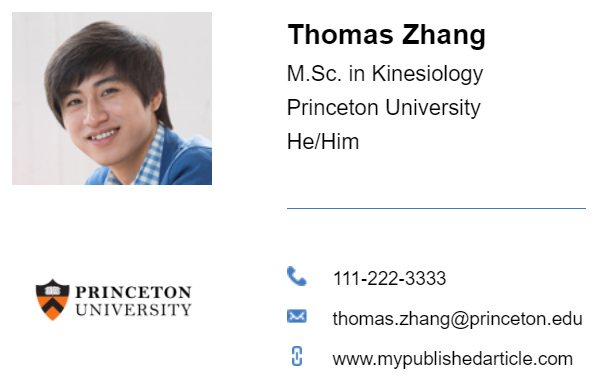
Ph.D. student example
Finally, see below for an example of a Ph.D. student email signature.
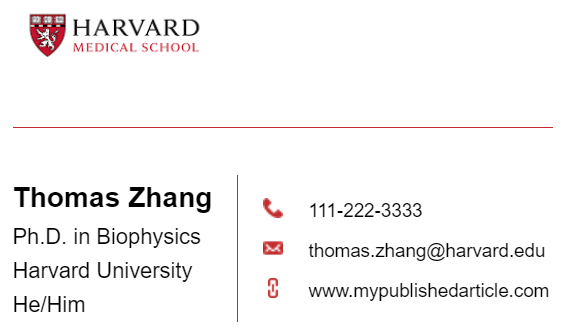
Free templates for college, master's, and graduate students
Once you're ready to create your own signature, templates can be a huge help. Alternatively, you can always type out a few lines into your email program, but why not do things with style?
The following websites provide great templates, often for free.
A great place to start is with HubSpot's completely free email signature generator . It's an excellent program. However, it can sometimes be a bit lacking in terms of template variety.
If none of their styles jibe with you, then seek out some additional inspiration with mailsignatures’ free signature generator and templates .
If you're searching for other options, you should also check out Gimmio's free email signature generator . You can only create one signature before being asked to sign up, but it might just be the only one you need.
Design considerations
Here are some important design considerations for undergraduate and graduate student email signatures:
Follow these tips to create a stylish, effective email signature:
- Do use only one font type
- Do use only one to three colors
- Do consider the psychological impact of the colors you choose
- Do create visual interest with a professional headshot, crest, or logo
- Do compress your image files (you'll want them to load easily)
- Do position social media, portfolio, or project links along the bottom or edge of your signature
- Do separate information with columns, bars, or other design elements
- Do ensure that your signatures look good on desktop and mobile
These tips will help you avoid a clunky or broken signature:
- Don't use clashing colors
- Don't use more than three colors
- Don't link to personal or unprofessional profiles
- Don't use large, blurry, or stretched images
If you follow the advice above, you should be well equipped to create a professional undergraduate or graduate email signature. The only thing left to do is to pick a template and get started.
Once you're happy with your signature, consider whether you'd like any additional help with the content of your email or the application essays , resumes , papers , or other important documents that you might attach to it. Scribendi's professional editors and proofreaders have helped thousands of writers across the world achieve their dreams. All you need to do is reach out.
Image source: Prostock-studio/elements.envato.com
Land Your Dream Job with a Professionally Edited Resume
Let our expert editors help, or get a free sample, about the author.

Have You Read?
"The Complete Beginner's Guide to Academic Writing"
Related Posts

10 Reasons to Hire a Professional Editor

How to Format a Resume

How to Write a Cover Letter
Upload your file(s) so we can calculate your word count, or enter your word count manually.
We will also recommend a service based on the file(s) you upload.
English is not my first language. I need English editing and proofreading so that I sound like a native speaker.
I need to have my journal article, dissertation, or term paper edited and proofread, or I need help with an admissions essay or proposal.
I have a novel, manuscript, play, or ebook. I need editing, copy editing, proofreading, a critique of my work, or a query package.
I need editing and proofreading for my white papers, reports, manuals, press releases, marketing materials, and other business documents.
I need to have my essay, project, assignment, or term paper edited and proofread.
I want to sound professional and to get hired. I have a resume, letter, email, or personal document that I need to have edited and proofread.
Prices include your personal % discount.
Prices include % sales tax ( ).


Craft the best PhD student email signature! [My secret weapon]
Email is the cornerstone of academic information exchange. Emails are used to reach out to potential collaborators, purchase equipment for your PhD, and communicate with other PhD students and academics. It is so important that your PhD student email signature contains all the important information in an easy-to-read layout.
The best PhD student email signature includes your full name, current position, the name of your University, Department or research group, email address, your academic credentials, and should include extras like a simple tagline so people know what you do.
Many excellent PhD student email signatures also contain very simple design features that allow the reader to easily pick out the most important information about you. Including columns, icons, punctuation and symbols.
Your email signature can include a photo, logo of the University, and links to other multimedia that builds credibility and trust with the receiver of your email.
This article will go over everything you need to know about crafting the absolute best PhD student email signature possible and will include my secret hack for ensuring you leave the best and most impactful impression.
Key elements for your PhD student email signature
There are many key elements to a successful PhD student email signature.
Obviously, we have all heard of having to include your full name, but have you considered what else you can put into your email signature?
In the table below, we will go through all the most important elements that should be included in your email signature.
Make sure you have everything on this list:
If your university has a style guide for your email signature, consider using this as a starting point for your own.
Using the University’s brand colours and logos will help you remain congruent with your colleagues and the brand of the University in which you are performing your studies.
Design of your PhD student email signature
The design of your email signature should be kept as simple as possible.
Before using any colours first you must consider the layout of your email signature.
The easiest thing to do is to list your details one after another on separate lines. Using simple symbols and punctuation can help people navigate your email signature easily.
For example, you can use ‘|’ to separate information in your email signature.
Here is an example of a very simple email signature that you can build from:
Andy Stapleton, MChem
PhD Student | Department of Physical Sciences | Flinders University
email: [email protected] | tel: +61 8 82017978 | ORCID ID | LinkedIn
This is a really simple way of providing a quick summary of your academic research and contact information.
Also, using columns and colours can start to draw your eye to the important components of your PhD student email signature.
One great resource for email signature design is Canva .
You can browse many options until you find one that stands out to you:
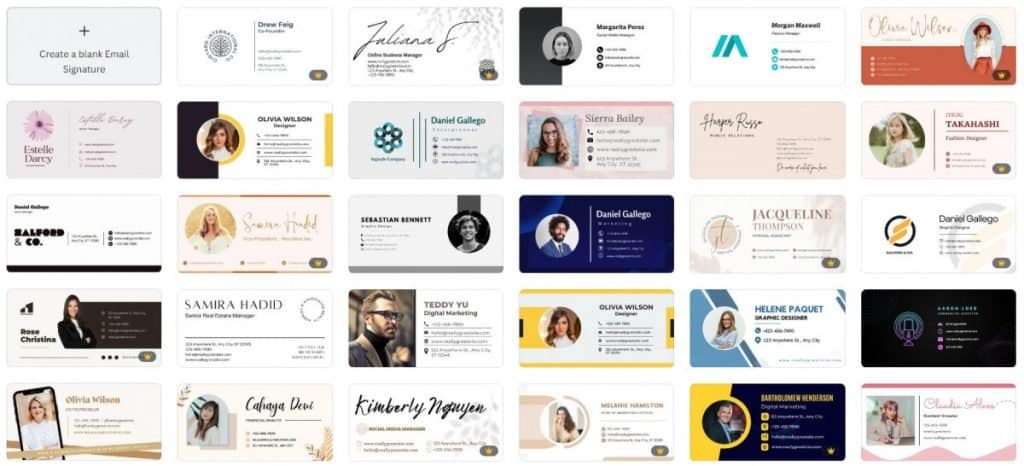
And the best thing is that you can do this completely free!
Examples of PhD student email signatures
Here are some excellent examples of various email signatures that can be used to inspire yours.

You will notice that the examples of PhD student email signatures use design to highlight the most important information.
Arguably, the most important information about you includes your name and where you can be contacted. These are the most important components of every email signature.
However, there is something that not a lot of email signatures use but can really help encourage people to want to know more about your work.
Let’s talk about my secret weapon of adding a simple tagline to your PhD student email signature so that you can maximise the impact of your email signature.
My secret weapon: adding a simple tagline
The formula for creating the perfect PhD student email signature tagline include answering these simple questions and then putting them all together.
The reason it is important to include a simple tagline is because a person’s field of study does not necessarily give anyone an idea of what skills they are building and what the significance of the research really is.
The formula for crafting your tagline is as follows:
who you help + what you help them achieve + how you do it

Let’s talk about each of the components.
1. Who do you help
Firstly, most people are doing research to help make the world a better place. You may be helping industry, a certain field, or even performing blue sky research.
Examples of who you can help:
- industry – Helping the energy industry, helping the medical industry et cetera
- field or people – helping doctors, helping cancer patients, helping students, helping parents et cetera
- blue sky examples – helping the world, helping science, helping save people from…
Including this as your first part of your tagline means people know exactly who your research benefits the most.
2. What do you help them achieve
Secondly, you need to include what you help people achieve. This can be what the outcomes of your research will be, and allows people to understand why they should care about your research
Examples include:
- … Create a renewable fuel…
- … Understand the processes of the human body…
- … Making solar panels cheaper…
- … Making health care more affordable…
- … Increasing the survivability of brain cancer…
Including this second part in your tagline will allow people to understand the true outcomes of your PhD research.
3. How do you do it
Lastly, you will need to include how you do your research. This will provide someone with an insight into your expertise and your skill base.
- … Using custom fibre optics.
- … Using atomic force microscopy.
- … By synthesising new cancer-fighting molecules.
- … Crafting solar paints and inks.
This is an important part to allow people to understand what skills you are likely to gain through your PhD and, whether or not your specific skill set will be something that they will want to approach about four collaborations or further information.

Putting it all together
Placing the three components of the email tagline together means you get examples such as:
- helping the health industry improve patient monitoring using advanced fibre optics
- helping the energy market deliver cheap hydrogen fuel with new catalysts
- helping the solar industry produce more cost-efficient solar cells using solar paint
- Uncovering the most efficient ways to manufacture drugs with flow chemistry
Include this in your PhD student email signature and I guarantee your recipient will understand much more about how you can be valuable to them. It increases the likelihood of them reaching out to you and asking for further information about your PhD and skills.
My very simple email signature could look something like this:
Dr Andy Stapleton MChem, PhD
Producing cost-effective solar cells using nanotechnology and solar paint.
Purpose of a PhD email signature
After crafting your PhD email signature you should ask yourself whether or not your PhD email signature is providing the intended outcome.

Is it simple enough to scan? Does it establish trust in the receiver? Are they able to understand what you do? And does it provide them with enough information to contact you on a number of platforms?
The purpose of an email signature should be to help facilitate the conversation and here are all of the outcomes that you want your PhD student email signature to achieve.
Identify yourself
Obviously, the first thing that a PhD student email signature should achieve is identifying who is sending the email.
Make sure that your name is one of the most obvious things on the email signature. You can do this by bolding the font or by using an accent colour.
Establish trust
Establishing trust in the person sending the email is another very important aspect of a great email signature.
In one glance someone should be able to see the university that you are affiliated with, your expertise, and any supporting information such as your ORCID ID.
Also, if someone was to forward on your email to someone else you want them to be able to see that you have the appropriate credentials to be someone to listen to.
Making sure that you follow any guidelines from your university’s style guide is also an important way of providing a congruent email signature with your colleagues.
Consider using the same colours as outlined in your university style guide to help you match your email signature with the brand of the University you are currently studying at.
Provide contact information
Another important purpose of a PhD student email signature is to provide contact information for further discussion.
Sometimes people like to take their conversations on to other platforms so considering putting in other professional social media such as LinkedIn or research gate.
Do not place the full links in your email signature.
The best way to include your contact information is to embed an icon into the signature and hyperlink to the appropriate platform.
Alternatively, you can use a simple word with a hyperlink. In your email hyperlink using “mailto:” before your email address will allow them to immediately send you an email. For example, mailto: [email protected] as the hyperlink.
Another thing to consider is including a link to a one-page website about your research. Producing a personal academic website is very easy and can be done in as little as an afternoon. Alternatively, you can link to your groups/supervisors/department’s best web page or site.
A personal academic website is a perfect way to provide a short summary of your work and your publications, outputs, and expertise so that it is in one place and easy to find.
Encourage them to find out more about you
adding the tagline will encourage people to want to find out more about you and your research.
One of the missed opportunities of a PhD students email signature is providing the recipient with a short summary of your research.
Using the tagline mentioned above, you will be able to encourage curious recipients of your email to dig deeper into you and your expertise.
This a fantastic way to start building your personal brand.
Provide simple links
An email signature is a perfect place to put any links to your academic achievements or expertise.
Do not overwhelm your recipient with too many links. Alternatively, you can use a link aggregated service such as linktree for a single button in your email signature that takes them to all of the links to find out more about you.
Wrapping up
This article has covered everything you need to know about producing the perfect PhD student email signature to inform the recipient of who you are, build trust, and spark curiosity in finding a little bit more about who you are.
Simple is always better when producing an email signature and simple colours with icons that link to various social media or contact information is, currently, one of the cleanest and nicest ways to include all the information you need in a PhD student email signature.
Be sure to include a very simple sentence tagline to boost the click-through rates of your links and provide the recipient with the perfect simple summary of exactly what you do. It’s one of the most underutilised opportunities for growing your personal and professional academic brand.

Dr Andrew Stapleton has a Masters and PhD in Chemistry from the UK and Australia. He has many years of research experience and has worked as a Postdoctoral Fellow and Associate at a number of Universities. Although having secured funding for his own research, he left academia to help others with his YouTube channel all about the inner workings of academia and how to make it work for you.
Thank you for visiting Academia Insider.
We are here to help you navigate Academia as painlessly as possible. We are supported by our readers and by visiting you are helping us earn a small amount through ads and affiliate revenue - Thank you!

2024 © Academia Insider


6 Essential Tips to Create a Stunning Graduate Student Email Signature
- August 26, 2020
- CAREER SKILLS

An email signature plays a vital role in the modern world. There is so much tension when it comes to choosing the right kind of signature to use for our emails. Although a signature may not be of great importance for personal use, a graduate student email signature is effective and important for professional and educational use.
It is important to have a graduate student email signature that is simple, brief, and straight to the point. First of all, as a student, you need a signature because someone can tell more about you by just having a look at your signature. This does not mean that you should put so many things in your signature, as too much information is also not giving readers a good expression about yourself.
For any student, the required elements for a graduate student email signature are just a few personal details that help one know who you are. Some information that should appear on your signature are full name, your major, name of the University or College, your year of graduation, email address, phone number, and a personal or social networking website.
1. Do’s when creating a graduate student email signature
- Be as brief and minimal as possible with your graduate student email signature.
- Write an email signature that is not more than four or five lines. The maximum should be six lines, and anything beyond this is considered irrelevant. It will make your email signature look complicated.
- You can use your image or a logo of your University in the graduate student email signature.
- Use Italics or Bold wherever possible, or when highlighting important information as it draws the attention of the reader.
- Include your role in University if you have to. For instance, you can say that you are a student’s financial security, head of public relations, or a campus ambassador.
- Include your social website if you have one in your graduate student email signature.
2. Don’ts when creating a graduate student email signature
- A graduate student email signature is not a resume!, therefore, try to avoid mentioning details such as your achievements, personal skills, and certificates.
- Do not include quotes in your email signature as what works for you may not work for another person. In addition to that, the person reading your email signature might find the quote offensive.
- Do not include any religious or Bible verses in the email signature.
- Do not add contrast font colors as it might make reading your graduate student email signature difficult.
- Add your institutional address (If applicable to you) because it’ll prevent your email ended up in the spam folder.
To catch the reader’s attention, a graduate student email signature should be written in a professional style. In addition, those who are looking for a starting point when crafting an impressive graduate student email signature can get an idea from this example.

3. Tips for writing the best graduate student email signature
3.1 use the best font for your signature.
Using a proper font will add more versatility to your email signature. Some of the fonts that can be used in any proper email signature include the following.
- Times New Roman
These fonts are available both on smartphones and are already installed on windows and mac platforms. Furthermore, you can use any font size from 10 to 12, depending on the readability of the work. You should also choose your colors wisely because choosing many colors will make your signature look too sophisticated.
3.2 Make people remember you
People should remember you for the right reasons and not the wrong reasons. When you send an email message to your tutors, or employers, with a professional email signature, it will make you look professional . This will make you more memorable as compared to a standard sign off.
3.3 Keep it short
Keep it short and to the point. The person reading your email signature should know more about you by just looking at the brief information you have on your email signature. The graduate student email signature should be personal, but do not overflow it with inappropriate personal information.
3.4 Include your email address, phone number, and address
An email address is important in your graduate student email signature as it makes it much easier for the recipient to contact you . In case of any concern, the recipient may contact you for further guidance. Listing your phone number is also important in many cases because it’ll help other people to reach you directly. A physical address should also be inserted so that the recipient can know where to send your letters to.
3.5 Make sure that the name you’re using is in the correct format
For a student email signature, use your names, including any middle name if there is any. Avoid using any nicknames in your graduate student email signature.
3.6 Use Hierarchy
Using a hierarchy helps in communicating the important information especially since the email signature contains important information. Using a hierarchy in a graduate student email signature is important because it captures the attention of the reader.
4. Conclusion
Using a graduate student email signature is important because it gives the recipient a rough idea of who you are and your professional achievements. Furthermore, you should avoid using too much information in your signature because the idea of including a signature in your email is only to introduce yourself, not to distract the reader. Make sure to choose easy-to-read font sizes, font types, and colors.
Images Courtesy : Photo by Stephen Phillips – Hostreviews.co.uk on Unsplash , Marketing vector created by stories – www.freepik.com
Aruna Kumarasiri
Founder at Proactive Grad, Materials Engineer, Researcher, and turned author. In 2019, he started his professional carrier as a materials engineer with the continuation of his research studies. His exposure to both academic and industrial worlds has provided many opportunities for him to give back to young professionals.
Did You Enjoy This?
Then consider getting the ProactiveGrad newsletter. It's a collection of useful ideas, fresh links, and high-spirited shenanigans delivered to your inbox every two weeks.
I accept the Privacy Policy
Hand-picked related articles

3 proven tips to build your online researcher identity as a graduate student
- October 6, 2022

3 Essential Features of a Great Academic Presentation
- July 5, 2022

How to make the most out of your first conference: 4 essential tips
- June 17, 2022
Leave a Reply Cancel Reply
Your email address will not be published. Required fields are marked *
Name *
Email *
Add Comment *
Notify me of follow-up comments by email.
Notify me of new posts by email.
Post Comment
Our products
- Email signature generator
Create a stunning email signature for yourself within a few clicks
- Email signature manager
Manage your teams email signatures and gain control over your brand
- Gmail signature
- Google Workspace
- Outlook signature
- Outlook 365 signatures
- Exchange signatures
- See all platforms
- Education facilities
- Real Estate agencies
- SaaS companies
- Health care
- Finance & insurance
- See all industries
- CEOs & executive
- Realtors & brokers
- Legal & lawyers
- Marketing & sales
- All signature examples
- Email signature examples
- Email signature templates
- Email signature design
- Email sign offs
- Email signature banners
- Handwritten signatures
- Disclaimer templates
- Cool signature templates
- Minimalist templates
- Animated templates
- Banner templates
- Signature generator
- Banner maker
- Email disclaimer generator
- How to add signature in Outlook
- Add a signature in Outlook 365
- Add signatures in Exchange
- How to add signature in Gmail
- Add multiple Gmail signatures
- Google Workspace signatures
- See all guides
- Email marketing updates
- Digital marketing hub
- Branding & PR
- Business updates
- Tech & IT
- Product updates
- Our features
- Help center
- 24/6 support
- Contact sales
- User reviews
- Terms of service
- Privacy policy
- Security and compliance
- Trust center
Users stories

See how companies save time & money automating their email signatures
Home / Email signature examples / Academic email signature
How to make the perfect academic email signature
Tips, examples and professional templates you can apply to give yourself an impressive professor email signature in under 5 minutes.
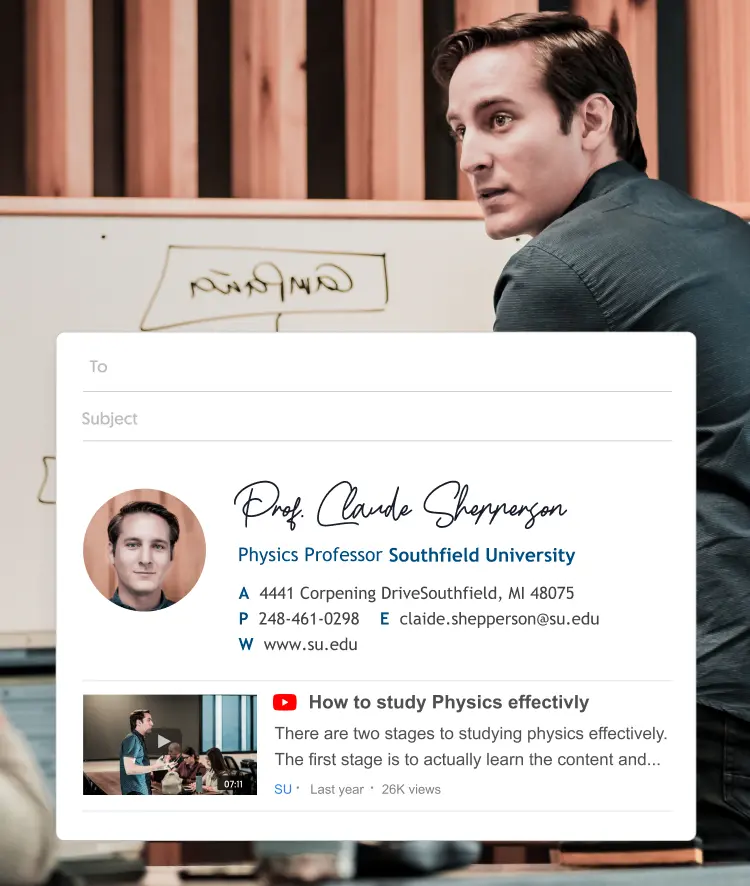
Short answer
What should an academic email signature include?
- First and last name
- Academic or administrative title and department
- The name of your educational institution
- Your workplace address
- Direct phone number
- Linkedin link (and other job relevant social media links)
- Some call to action (a banner, a button or a link)
- A high quality image of you and/or a logo of your workplace
What’s on this page
- The 5 Elements of a perfect academic email signature
- Academic email signature templates
- How to manage academic faculty email signatures (for educational institutions)
5 Elements of a perfect academic email signature
A good looking academic email signature can put you before your peers and score you some points with your email recipients. There is only one opportunity to make a first impression, so make sure that your signature creates the right impression with these 5 essential rules.
Professional information should be clear, relevant and actionable
Include all of the relevant professional information for your academic email signature. Be sure to use your full name (including middle initial). Be sure to give your real and current job title and the proper name of the educational institution you work in.
When it comes to contact information, use an address and phone number where you actually intend people to contact you. In case you prefer to avoid giving out your direct phone number, make it clear to your readers that the number you gave is your office number, the university central desk, or some other extension.
Create a deeper connection with your contacts with links to your social media
If you have a blog, a Facebook page, a Twitter account, or a Youtube channel that details your professional academic activity, consider including links to your social media accounts in your signature .
If you don’t own any of these digital media assets but your college or university does, consider adding those instead.
Let your email recipients know about all of the different locations online that they can find you, learn more about what you do, and continue their engagement with you.
If you can encourage your email recipients to extend their communication with you to a social platform, you are well on your way to creating a deeper connection with your contacts.
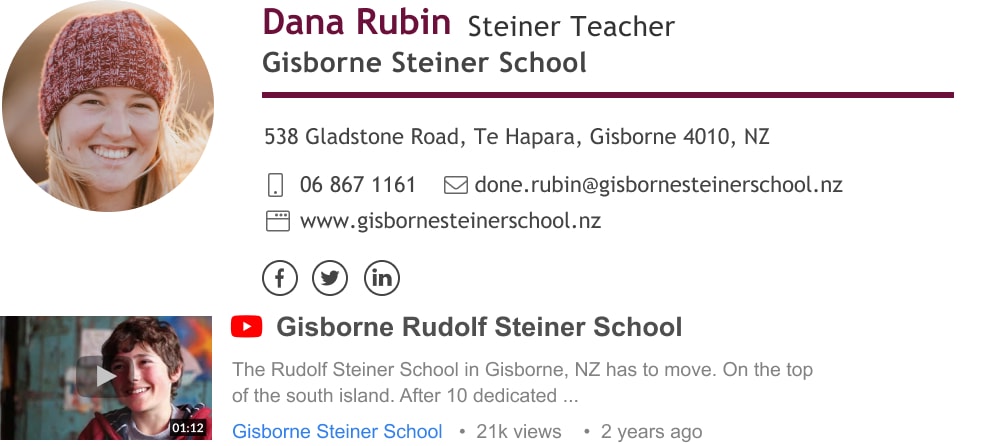
Get personal and encourage engagement with social media icons or a Youtube video
Your university logo and brand colors will lend you their credibility and professionalism
Having your college or university logo included in your signature provides instant trust for viewers outside your institution, and makes you look more professional for viewers within your institution.
Using your brand colors correctly in your email signature will further amplify this effect because colors are easily recognizable and intuitively associated with your workplace (especially if it’s a known brand).

A signature using MIT’s brand color
An important detail to keep in mind when adding your logo is that you don’t want it to show up as an email attachment, because the email will then take up extra space in your recipient’s inbox and may deter them from opening the email.
But when you use an email signature builder tool like WiseStamp, the image is added as part of the signature HTML code and not as an attachment.
A respectable photograph will make a respectable professor signature
To streamline the creation of signatures across your school or university, allow your staff to add their personal info by themselves. They may also want to slightly tweak their signature to fit their personal taste and needs at no cost to the organization. They may well see this gesture as a bonus and service to them.

A professional looking professor email signature
Add a call to action to promote your work or publications
As an academic, whether you’re an educator, a teacher, a professor, or a researcher, you most likely have something that you do that you want people to know about.
Adding a call to action will greatly improve your chances to get people on board with whatever it is you want them to take part in.
If you offer a paid-for article, a private tutorship, online lectures, or even organizing some event or fundraiser. Whatever it is, consider adding a banner, a button or a link to offer it to your readers. This type of call to action is eye-catching and easy for readers to act on with a click.
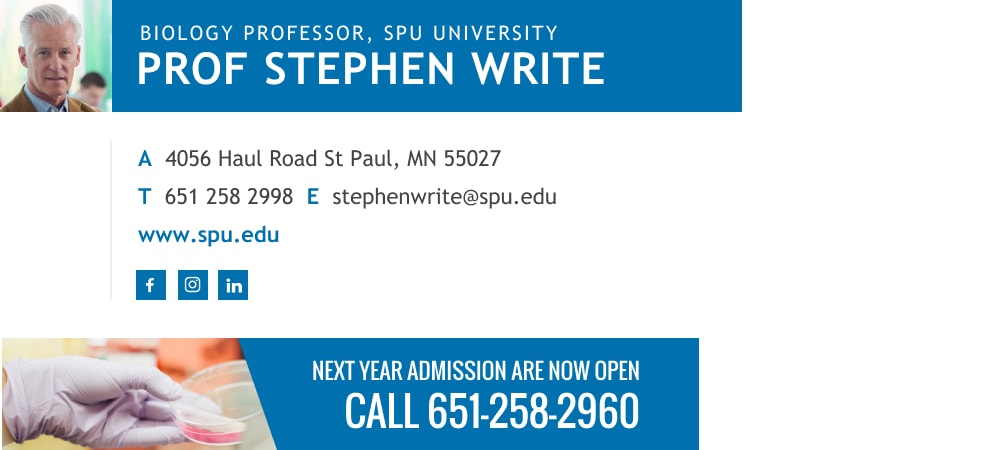
Academic Email signature with a Call to Action clickable banner
These were the basic elements that we recommend adding to your email signature though you may want additional information as well.
As a professor or an academic educator, you may also want to include mentions of upcoming events at your university or school, fundraisers, or a new blog post.
Just don’t go overboard because an overly-long signature becomes cumbersome and may take away from the main goals for which you made it in the first place.
Looking for the perfect email signature for academics? – try WiseStamp .
Academic email signature templates you can use
Unify your academic faculty email signatures (for educational institutions)
An email signature not only provides your recipients with easy-to-find contact details but it’s also a great way to share valuable information about your institution, such as special recognitions or upcoming events.
By optimizing your staff’s email signatures you can transform each email into a marketing opportunity for your organization. With WiseStamp email signature manager, it’s easy to create a professional-looking email signature with standardized settings for all of your faculty, using one of our many email signature templates .
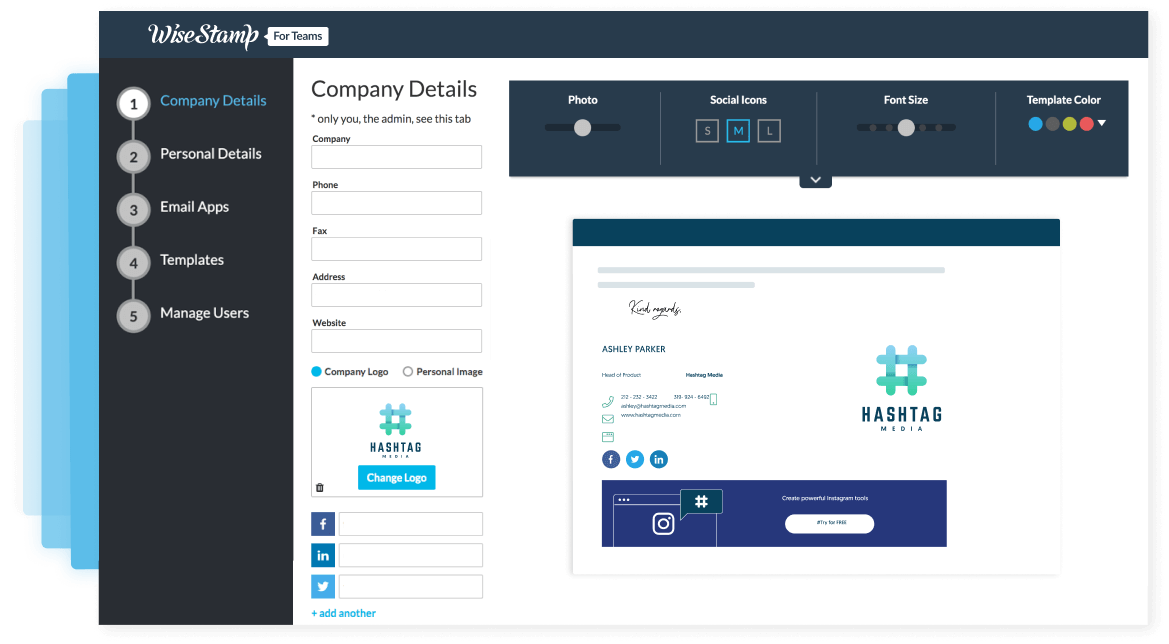
WiseStamp email signature manager for academic institutions
The basic idea behind an email signature is to make it easy for your recipients to quickly identify your institution and get the essential information about your staff members like their name, title and department. The signature acts as a go-to location at the bottom of your emails where your organization and team’s contact details can be easily found.
Like a storefront, the way you display your information is just as important as the information itself . This is why making a professional-looking signature will reflect positively on your staff’s and your organization’s professionalism.
- CEO & executive signatures
- Owner & founder signatures
- Realtor email signatures
- Lawyer email signatures
- Doctor email signatures
- Nurse email signatures
- Teacher email signatures
- Student email signatures
- JD candidate email signatures
- Academic email signatures
- Blogger & writer signatures
- Graphic designer signatures
- Musician email signatures
- Artist email signatures
- Military email signature
- Engineer email signatures
- Assistant email signatures
- Consultant email signatures
- Marketing & sales signatures
- Photographer email signatures
- Startup team email signatures
- Job seeker email signatures
- Contractor email signature
Free email signature generator
Popular features:
- 1-Click setup in your email
- Designed template options
- Add-ons for every need
We use cookies on our website to make sure you get the best experience from your visit. Please confirm that you accept the use of cookies & our privacy policy .
A student's guide to professional email signatures
What's on this page:.
Thinking about the future is daunting. But a professional email signature can help support your next step. Read the guide to find out how👇
“Think about the future...”
As a student, this is something you’re told a lot. Whether you’re in school, college or university, you’re always thinking about that scary next step.
But don’t panic.
Networking can help you get in contact with people that can help you secure internships, volunteering posts, and even your first job.
And a professional email signature can help with this.
How so, you might ask?
Keep reading this guide. We’ll take you through why you need to have a signature, and give you some guidance on creating one.

What are the benefits of student email signatures?
As a student or recent graduate, you're in demand.
Different industries are all on the lookout for fresh, interesting, and creative ways of thinking.
And a professional email signature helps you stand out from the crowd.
It shows you’ve got an independent mindset and that you take the next step in your development seriously.
But, it’s not only about securing jobs. It’s also about:
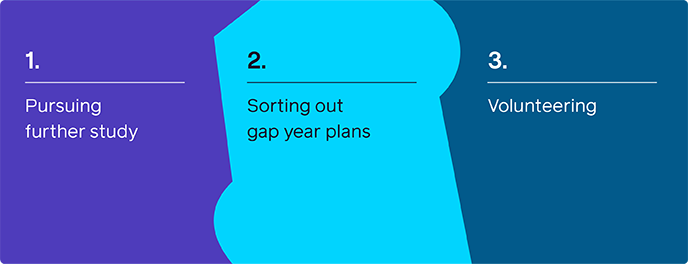
So whatever you want to do next, a professional email signature is your secret weapon.
Student email signature best practices
Creating your professional student email signature goes beyond just including your contact details.
Because specifics are the only thing that can help you generate relevant job, volunteering, and academic opportunities.
If you’re feeling a bit lost, or you don’t know where to start, we've got you covered 👇
Keep it brief 💬
An email signature is a small space. It has to cover a lot of information at the same time.
Don’t waffle or explain your life story. Keep it simple and brief.
Use clickable icons to direct your network to sites where they can find out more about you.
If it’s super wordy, you’ll immediately lose the interest of the recipient. It’ll be too overwhelming and tricky to follow.
The language should always be formal. Remember, you’re networking with professionals.
Consider phrases such as “Many thanks” or “Kind regards” and don't overuse emojis.
Note your stage of education 🏫
We know this seems like an obvious point. But it’s an important one.
Because it means you’ll be able to get in touch with relevant people and opportunities. There’s no point in someone contacting you about a first-year university internship if you’re still in school.
So, state if you’re:
- A student at a high school or sixth form
- An undergraduate, postgraduate (masters or pHD) student
State your degree or major 🎓
Once you’ve outlined your level of education, you can add what you’re studying.
If you’re at school, think about the classes you’re studying. It’ll show what you’re interested in. For example, if you’re in the UK, think about putting in your chosen GCSEs and A-Levels.
If you’re at university or college, state your major. Are you a history or a chemistry student? Make it clear to people.
And to really go the extra mile, put in some predicted or expected grades.
Have a professional photo 📷
A pixelated or low-quality photo will ruin the quality of your signature.
Remember: you’re putting a name to a face. Click the subtitle for some detailed guidance on how to take a professional email signature photograph.
Include social media icons 🤳🏿

This is a great way to show off your personality and interests.
But, be careful about the social media sites you include.
Don’t link your personal Instagram page if it’s inappropriate or centred around your friends and family. It won’t look great when you start networking.
The most obvious one to include is LinkedIn. It’s a professional social site, and it’ll allow you to grow your network quickly.
You can include others, but just make sure they’re relevant and they reflect well on you. And remember to be selective otherwise the signature will look too cluttered.
Include your hobbies and interests outside of studying ⚽️
Student life isn’t all about studying. There’s so much more to it, and your email signature can express that.
State your involvement in extracurricular activities on your email signature.
But don’t include a long list! There’s limited space. Link your CV if you can’t pick just one thing.
If you’ve recently been part of an event at school or university, a call-to-action (CTA) is really useful for directing someone to the content around it.
For example, if you recorded and uploaded a panel as a YouTube video, insert a clickable icon to direct someone to it.
If the event hasn’t happened yet, a CTA is great to direct someone to an Eventbrite page, for instance. They can follow this link, sign up and get tickets.
Use calls-to-action (CTAs) ⏭
It’s already been mentioned that you can’t include every single detail under the sun in your email signature. The space is too small.
The way to get around this? Use eye-catching, clickable CTAs .
For example, you can include a CTA that directs the recipient to an automatic download of your CV. That way, the recipient will learn information about you that isn’t displayed on your signature.
You can also use a CTA that automatically downloads a written reference from your supervisor from work experience or your school/university.
Using student email signatures to support your future plans
At least once or twice throughout your time a student, you’ve probably been asked these questions:
- Now that’s over, what’s next?
- What are you going to study at uni?
- What’s next after you’ve finished uni? Have you got any plans?
It’s annoying to think about. But it’s important, and your email signature is a great place to start. You can use this small text space to let people know what you’d like to do, or what you intend to do.
Use phrases such as:
- Open to a job in [industry]...
- Open to apprenticeships in [industry]...
- Looking to study [subject] at [university]...
If you're unsure, you could speak about specialist skill you have or sectors you're interested in.
An email signature could help open a door you hadn't considered.
Of course we’re not saying you’ve got to commit to one thing. Plans change - it’s part of the parcel of being a student. But, you’ve got to start somewhere. So, it’s better to put something down rather than nothing.
And remember, you can always come back and update your signature once you have a better grasp of your future plans.
Here are some examples of how you can tailor your signature to specific future plans:
Employment 👨🏻💼
Future employment is probably one of the most common paths for students to follow.
You can use your email signature to build networks with people and get a head start on other students.
There’s no rule saying you can only state your career plans while you’re in university. If you’re in school and you’re figuring out career plans, let people know on your email signature.
You can also state if you’re actively looking for a part-time job on your email signature. For example:
- Looking for weekend work in [industry]...
Your email signature can generate useful, meaningful conversations - and help with your employment search.
Further education 🤓
If you’re about to finish school, you should use your email signature to notify people about what you’d like to study, if this is your next plan of action.
This means you can start reaching out to professors at other universities. If you state your interest in a subject, professors might let you know about upcoming events or summer school programmes at universities.
You can also reach out to scholarship organisations or sponsors if you're in need of financial aid for your education. In many cases, along with your application, you may need to write an impressive scholarship essay that outlines your achievements, goals, and why you deserve financial assistance from the organisations. Crafting a compelling essay is essential to stand out among the applicants. If you find yourself unsure about how to create an impactful scholarship essay, you might consider seeking assistance. StudyCrumb offers scholarship essay writing help , providing guidance and expertise to help you present your story and aspirations effectively. With their support, you can increase your chances of securing the financial aid you need to pursue your educational dreams.
If you’re about to finish university, you can use your email signature to let people know about what and where you’d like to study next. Your network can keep you in touch and reach out to you about talks or tours.
Gap year plans ✈️
If you're planning an extended break, you might want to pick up a new skill, get some volunteering experience, or travel.
Let your network know if you’d like to take a year out, and how you’d like to spend it.
Hostels and volunteer leaders may get in touch and help you support your gap year.
Regardless of how you use it, your email signature will drive great conversations, whether it continues to be on email, over Zoom, via social media, or on the phone.
The key components of a student email signature
The key components of your professional student email signature are:
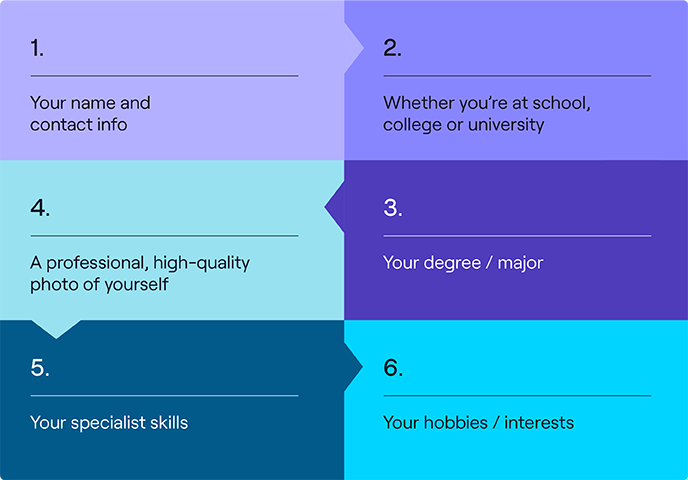
By including all these things, you'll help build your network, support your future plans, and stand out from others looking for similar opportunities.
You should also:
- Use your email signature as an opportunity to express your future plans, or at least an idea of what they might look like.
- Use CTAs to include more detailed information about you, such as your CV or references.
Student email signature FAQs
Should I have an email signature as a grad student?
Yes. It will set you apart from other graduates, as you’ll demonstrate a professional attitude. Besides that, it’s just a good habit to have.
How do you sign a college email?
It’s important to remember that at college or university, you’ll be communicating with distinguished people in their fields.
Remember to sign off with “Kind regards,” “Best” or “Many thanks”.
What should I include in my email signature as a college grad?
You should include the following:
- Your name
- Your contact information e.g. a phone number
- Degree and classification
- Graduation year
How do I add a master's degree to my email signature?
There are a couple of ways you can include a master's degree in your email signature.
- Add the masters after your name. For example, if you’ve got a master's in a science subject, write: [subject] MSc.
Add it as a separate line of information in your signature.
- Contact information
- Masters degree and classification
How do medical students sign emails?
Requirements are slightly different for medical students. Here are a few things you should include:
- State the year of your degree
- State the medical school you’re studying/currently attending
- State whether you’re on a practice or placement year at a hospital or practice
However, as always - keep the information brief!
How do I create a student signature in Gmail ?
- Open ''Gmail'' and sign into your account
- Open ''Settings''.
- Scroll down to ' 'Signature'' under the ''General'' Tab.
- Click on ''Create new'' under the ''No Signatures'' section.
- Type in your signature
- Once you've finished, scroll down to the bottom of the page.
- Click on ''Save Changes''.
How do I list my credentials in a student email signature?
State your latest degree, i.e. the one you’re currently studying, first. Then go in descending order. For example, if you’re currently doing a Masters degree, then it’d be:
- Masters degree title
- Undergraduate degree title
- Followed by everything else e.g. school
And there you have it! You're ready to create your student email signature. ✅
Read similar stories
Email signature tips.
_Card.png)
Want to leave a lasting impression on your prospects with email?
Try mailtastic for free.
The Ohio State University
Using virtual reality to better prepare nurses, our grads are prepared and ready for what's next, a healthier society with sustainable farming, take your next step:.
- Schedule a visit
- Explore majors
Creating a world people need now.
The future is not only what you dream about; it’s what you create. Together, we’re finding solutions for challenges that can’t wait.
A look at advanced manufacturing
Engineering our future leaders, affordability at ohio state, explore campus.
The Buckeye heart of The Ohio State University, located right in the heart of Ohio
Developing leaders with the resources and strength of the state’s top university
Bringing higher education opportunities to a broader community, throughout Ohio and beyond
Smaller campus, smaller class sizes but big opportunities to leverage the strength of Ohio State
Excellence in academics and innovative research opportunities paired with a supportive community
A critical component of our state-wide research enterprise with boundless opportunities
Ohio State News
Dentistry students play 'price is right'.
In Matthew Messina's Introduction to Clinical Dentistry class, students played games similar to the popular game show to learn the cost of dental equipment.
Fatty food pre-surgery impairs memory
Events celebrate graduate, professional students, climate change impacts lake erie zooplankton, president carter visits regional campuses, key issues at ohio state.
Ohio State strongly condemns all terrorist groups and terrorist attacks, including those perpetrated by Hamas on Israeli civilians, Americans and others the weekend of October 7, 2023. The university is deeply committed to supporting all students, faculty and staff and will address national and global matters through direct actions and interventions that actively support the university community and afford educational dialogue in safe and supportive environments.
Strauss Investigation
Ohio State condemns Strauss' reprehensible conduct and the university's failure at the time to prevent the abuse.
Additional Links and Resources
- Buckeye Link
Health and Wellness
- Wexner Medical Center
- Student Health Center
- Dental Clinics
- Optometry Services
- Buckeye Wellness
- Counseling Services
- Veterinary Medicine
- Board of Trustees
- Strategic Plan
Around Campus
- Visit Columbus
- Wexner Center for the Arts
- Schottenstein Center
- Ohio Stadium

IMAGES
VIDEO
COMMENTS
Key elements to include in email signatures for PhD students. Tips for creating a convincing email signature as a PhD student. #1 Know your audience when creating an email signature. #2 Keep your email signature short and simple. #3 Include hyperlinks in your email signature instead of long web addresses.
50. And it is generally regarded as incorrect to prefix your title and to repeat it after the name. Even with a single degree, you should either say "Dr. Bob Roberts" or "Bob Roberts, PhD". Saying "Dr. Bob Roberts, PhD" isn't good. So, if you really want to list all of your degrees, you should probably omit the title before your name.
How to Use a Doctorate with Your Name: 1-2-3-4-5 —-#1) Holders of doctorates who work in academia or research institutions are addressed as 'Dr. (Name)' professionally and socially in a salutation or conversation.Thus, a Ph.D. professor at a college, a Ph.D. in biology doing scientific research, and a Ph.D. principal at an elementary school all use Dr. (Name) and everybody thinks it is ...
Here are some tips to help you order your credentials after your name properly: Use commas. Use commas to separate the abbreviation for each of your credentials. This can make it easier for people to determine where one credential ends and the next credential begins. Double-check abbreviations.
When writing a name with a PhD after it, the correct way to do so is to use "PhD" or "Ph.D. or Ph.D". Depending on the preference of the individual, either form can be used. However, if the individual has a business card that states their degree in full, then the more formal "Doctor of Philosophy" should be used.
When creating an academic e-mail signature block for Walden University, as well as for most professional correspondence, you should only use the academic credential that you have earned after your name. You should not use amended forms of a degree (e.g., PhD-C or PhD (c)) to indicate partial completion of your program, nor should you use ABD ...
Keep it professional: While designing your formal email signature, make sure to stick to one font and avoid using multiple colors and sizes. The purpose is to enable readers to get an idea with just a glance at your signature. So keep it clean and simple. Make it visually interesting: Ensure that your formal email signature has a visual appeal.
4. Invite Further Exploration. Including a statement of purpose can stimulate recipients' interest in learning more about you and your studies. One of the overlooked potential uses of a graduate student email signature is to provide the recipient with a brief overview of your studies or research.
After you've listed your credentials, use a separate line to note your current position or title, such as Marketing Manager or Director of Operations. On the next line, either list the department or your employer. If your department doesn't have a name, go right to the employer, such as: Jon Johnson, MS, MBA Director of Marketing ABC ...
Separate their names with a comma. You can use the salutation "Dear" at the beginning if you'd like. If you aren't sure who has a Ph.D. and who doesn't, just use "Professor" for all of them. [2] You might write: "Dear Professor Jones, Professor Smith, and Professor Ali.". "Dr. Jones, Dr. Smith, and Professor Ali,".
With that in mind, here are the elements you should include in a professional student email signature, regardless of whether you're currently at the undergraduate, master's, or Ph.D. level: Your full name. Your title and/or major. Your higher education institution and/or department. Your email and cell number.
It is common for academics to use titles (e.g., Dr, Assoc Prof, Prof, etc.) in descriptions such as a signature block, staff page, etc. It is uncommon (but not incorrect) to additionally add the suffix "PhD". The main reason most academics leave this part off is because the degree is common among academics.
The best PhD student email signature includes your full name, current position, the name of your University, Department or research group, email address, your academic credentials, and should include extras like a simple tagline so people know what you do. Many excellent PhD student email signatures also contain very simple design features that ...
Put a comma followed by the title "Ph.D." after the name of a person who has earned a Doctor of Philosophy doctoral degree. For example Stacey Childs, Ph.D. Do not combine the title of "Ph.D." with any other title even if the person could appropriately be addressed by a different title. For instance, even if the person being addressed ...
I work in industry and use the following for my email signature: [name], PhD (job title & contact info underneath on separate lines). I often delete my signature entirely when sending internal emails and just write my first name instead. Anything being sent externally gets the signature. On resumes/cover letters I put [name], PhD into the ...
Tips for writing the best graduate student email signature. 3.1 Use the best font for your signature. 3.2 Make people remember you. 3.3 Keep it short. 3.4 Include your email address, phone number, and address. 3.5 Make sure that the name you're using is in the correct format. 3.6 Use Hierarchy.
Basically, by including a signature, you make it harder to read an email. This is normally just annoying, but it becomes extremely frustrating in long email chains or mailing lists, since no one bothers removing signature when they quote people. So, save everyone the trouble and don't send it in the first place.
Cold Emailing + Your Business Email Signature = More Conversions. You want to make a positive, strong first impression on your recipient in a cold email.You can't assume familiarity with them—it is a cold email, after all. But they're (ideally) going to want to know more about you, your company, and why you reached out to them—and your business email signature can answer these questions.
However, if you are unsure whether or not an abbreviation is appropriate, err on the side of caution and write out the full name of the degree. When adding your masters degree to your business card or signature, you can use either your full name or initials followed by your degree. For example: John Smith, Ph.D. or JS, Ph.D.
Include all of the relevant professional information for your academic email signature. Be sure to use your full name (including middle initial). Be sure to give your real and current job title and the proper name of the educational institution you work in. When it comes to contact information, use an address and phone number where you actually ...
It's personal 👤. As a doctor, you know about "duty of care". Patients need to feel like they're going to be looked after. That's why it's important to have a customised email signature. You can add in something like a professional photograph. You can put a face to a name, and humanise your email conversations.
And a professional email signature helps you stand out from the crowd. It shows you've got an independent mindset and that you take the next step in your development seriously. But, it's not only about securing jobs. It's also about: So whatever you want to do next, a professional email signature is your secret weapon.
Below are some tips to writing a professional email to a university or academic program as a graduate applicant. Subject Line: Your subject line should not be too long or too short. A statement such as "Questions on Chemistry PhD Funding" or "Clarification: MA Cybersecurity Requirements" can convey the intention of your email.
Ohio State condemns Strauss' reprehensible conduct and the university's failure at the time to prevent the abuse. Discover Ohio State, a mission-driven land grant university, home to the Wexner Medical Center and world-class graduate, undergraduate and research programs.